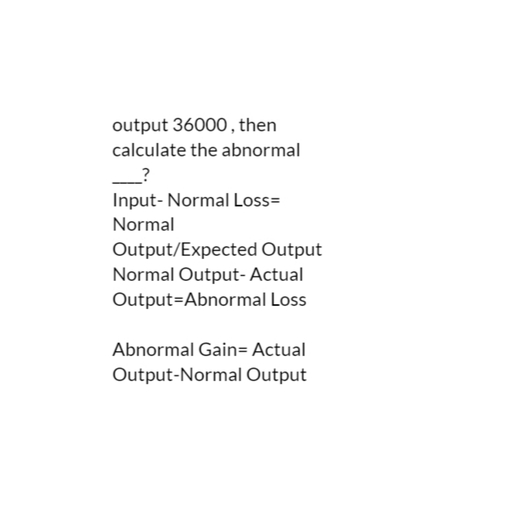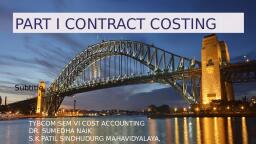Page 2 :
Definition, Contract Costing defined: ' Method where each contract is treated as cost unit and Profit & Loss is ascertained separately, employed by undertakings engaged in building, road & bridge construction, ship building, etc., The Institute of Cost and Management Accountants (I.C.M.A.) London, defines contract costing as, “that form of specific order costing which applies where work is undertaken to customer’s special requirements and each order is of long duration.”, “Contract or terminal costing is the term applied to the system adopted by those businesses which carry out substancial building or constructional contracts.” —Walter W. Bigg
Page 3 :
Concepts relating to Contract Accounts, Contractor: Person who undertakes the task of doing the job , Contractee: Person on whose behalf the task is being done , Contract Price: Value for which the contract is undertaken , Work certified: Part of the total contract price which is has been completed and approved by the architect , Uncertified Work: Part of the task done but not approved by the architect of the Contractee , Cash Paid: Part of the work certified that is paid by the Contractee , Retention Money: Part of the work certified that is held back by the Contractee
Page 4 :
Contract Costing Procedure, The basic procedure for costing of contracts is as follows:, 1. Contract Account: Each contract is allotted a separate number and a separate account is opened for each contract., 2. Direct Costs:, Most of the costs of a contract can be allocated direct to the contract. All such direct costs are debited to the Contract Account., Direct costs for contract include:, (i) Direct cost of materials,, (ii) Direct labour and supervision,, (iii) Direct Expenses,, (iv) Depreciation of Plant and Machinery,, (v) Sub-contract costs, etc.
Page 5 :
Contract Costing Procedure, 3. Indirect Costs:, Contract cost is also debited with overheads which tend to be small in relation to direct costs. Such costs are often absorbed on same arbitrary basis as a percentage on prime cost, or material or wages, etc. Overheads are normally restricted to head office and storage costs., 4. Transfer of Materials or Plant:, When materials, plant or other items are transferred from the contract, the Contract Account is credited by that amount.
Page 6 :
Materials:, (a) All the materials purchased for the contract or any material sent to site is charged to contract., (b) If any material is returned to stores or lying at site unused or materials transfers to another contract site is credited to the, Contract Account., (c) If materials are not required immediately, the materials may be stored and its cost is debited to Stock Account.
Page 7 :
labour, All the labour employed or worked at site is treated as direct labour and all costs relating to them is charged to the Contract Account. , The salaries and incentives of the administrative and supervisory staff of a specific contract is also charged to that specific contract
Page 8 :
plant, a) When the plant is taken on hire, the hire charges are charged to Contract Account., (b) If the plant is specifically purchased for the contract or plant was sent to site, the value of the plant is debited to Contract Account. The value of plant returned or remaining at site is credited to Contract Account. The balance between amounts debited and credited to contract represents the value of plant used at site., (c) Sometimes the value of depreciation provided on the plant is debited to Contract Account instead of showing the value of plant issued to site and remaining at site.
Page 9 :
Sub-Contract Charges: Sometimes part of the contract work is given on subcontract basis and payments made on subcontract work is debited to Contract Account, Overheads: The general overheads and head office expenses are apportioned to different contracts on equitable basis, and the portion of overheads are charged to the Contract Account.
Page 10 :
Work-in-Progress, Work-in-Progress: The amount of work-in-progress includes the value of work certified and uncertified appearing in the Contract Account., The work-in-progress is shown as Current Asset in the Balance Sheet as follows:, Materials at site, Plant at site are shown separately in the Assets side of the Balance sheet.
Page 11 :
Contract Costing Procedure, 5. Contract Price:, The Contract Account is also credited with the contract price. However, when a contract is not complete at the end of financial year, the Contract Account is credited with the value (cost) of work-in-progress as on that date. Work- in-progress includes value of work certified and the cost of work uncertified., 6. Profit or Loss Account:, The balance of Contract Account represents profit or loss which is transferred to Profit and Loss Account. However, when contract is not completed within the financial year, only the part of the profit arrived is taken into account and the remaining profit is kept as reserve to meet any contingent loss on the complete portion of the contract.
Page 12 :
Computation of Profit or Loss on Contract:, There may be three situations in the computation of profit or loss on contracts., They are:, (I) Profit on completed contracts,, (II) Profit on uncompleted contracts,, (III) Profit on likely to be completed contracts.
Page 13 :
I. Profit on Completed Contracts:, If a contract is begun and completed in the same financial year, then, the entire profit or loss made on such a contract should be transferred to the Profit and Loss Account. , If there is profit, the same should be credited to the Profit and Loss Account and debit should be given to Contract Account., On the other hand, if there is loss, the same should be debited to the Profit and Loss Account and credit being given to the Contract Account.
Page 14 :
Profit on Incomplete Contracts, Contracts which are started and finished during the same financial year create no accounting problems. , But in case of those contracts which take more than one year to complete, a problem arises whether profit on such contracts should be worked out only on the completion of the contract or at the end of each financial year on the partly completed work. , If profit is computed only on the completion of the contract, profit will be high in the year of completion of the contract, Whereas in other years of working on contract, profit will be nil.
Page 15 :
Profit on Incomplete Contracts, This would result not only distorted profit pattern but also higher tax liability because income-tax at higher rates may have to be paid. , Therefore, when contracts extend beyond a year, it becomes necessary to take into account the profit earned or loss incurred oh the work performed during each year. , This helps in avoiding distortion of the year-to-year profit trend of the business., There are two aspects of the profit computation:, (1) Computation of notional profit or estimated profit, and, (2) Computation of the portion of such profit to be transferred to Profit and Loss Account.
Page 16 :
Profit on Incomplete Contracts, The portion of the notional or estimated profit to be transferred to Profit and Loss Account depends upon the stage of completion of the contract. , Prudence requires that the total notional profit should not be transferred to Profit and Loss Account but a portion of it should be withheld as a reserve to meet any unforeseen future expenses or contingencies.
Page 17 :
Profit on Incomplete Contracts, Profit on Incomplete Contracts: , (a) When work certified is less than 25% complete :No profit or Loss be accounted for , (b) When work certified is 25 % or more but less than 50% :Notional Profit X 1/3 X Cash received ÷ Work Certified, (c) When work certified is the 50% or more but less than 90% :Notional Profit X 2/3 X Cash received ÷Work Certified , (d) When the contractor estimates the profit: Estimated Profit X Work Certified ÷Contract Price
Page 18 :
Loss on Uncompleted Contracts:, In the event of a loss on uncompleted contracts, this should be transferred in full to the Profit and Loss Account. Whatever be the stage of completion of the contract., If the total of debit side of Contract Account exceeds the total of the credit side of Contract Account, the resultant will be loss, which will be transferred to P/L A/c and not to Work-in- progress A/c.
Page 20 :
Tips for Solving Problems of Contract costing, Look at the date of beginning the contract and preparation of contract account, so that it can be ensured that for how much duration the particular contract is being prepared., Ensure whether the contract has been completed or is incomplete so far., In case of incomplete contract, determine how much proportion of completed contract bears to contract price. Is completed work less than 1/4 of contract price or is equal to 1/4 or more but less than 1/2 of contract price or is equal to 1/2 or more but less than 9/10 of contract price or is about to be completed.
Page 21 :
Tips for Solving Problems of Contract costing, As regards depreciation read carefully whether the term ‘per annum’ (p.a.) has been used with the rate of depreciation. , If yes, then look at the period for which the plant and machinery has been used on the contract. , If the word ‘p.a.’ has been used, then depreciation shall be calculated proportionately to the period the plant was in use on contract. , If the term ‘p.a.’ is not used, then depreciation shall be calculated for one year. , In such a case, the period of use of plant and machinery on contract shall not be considered.
Page 22 :
Tips for Solving Problems of Contract costing, If the contract is in the stage of completion, then estimated profit will have to be ascertained., If the amount of work certified is not given, it will have to be ascertained. It is ascertained on the basis of amount received from contractee as a fixed percentage of work certified., The value of uncertified work is always shown at cost, not at contract price. All expenses incurred by the contractor on contract from the date of certification to the date of preparation of contract account will be added to get the amount of uncertified work.
Page 23 :
Tips for Solving Problems of Contract costing, If material consumed as well as material in hand or at site are given, we can find out material issued to contract account by adding these two figures. , Material Issued = Material consumed + Material in hand or at site, In case the contract price is not given in question, then 2/3 of notional profit should be credited to Profit and Loss A/c.










































































